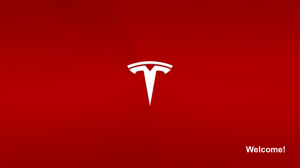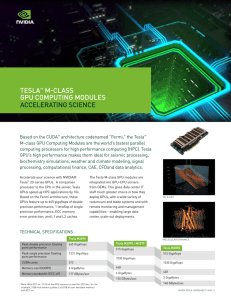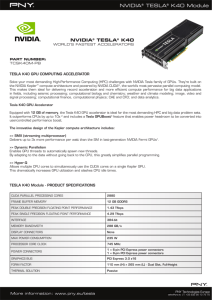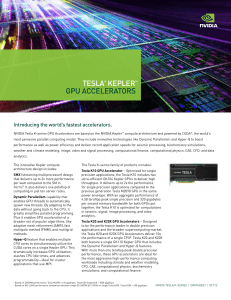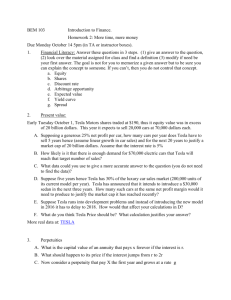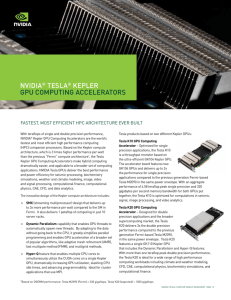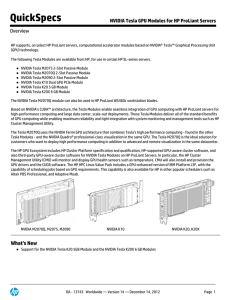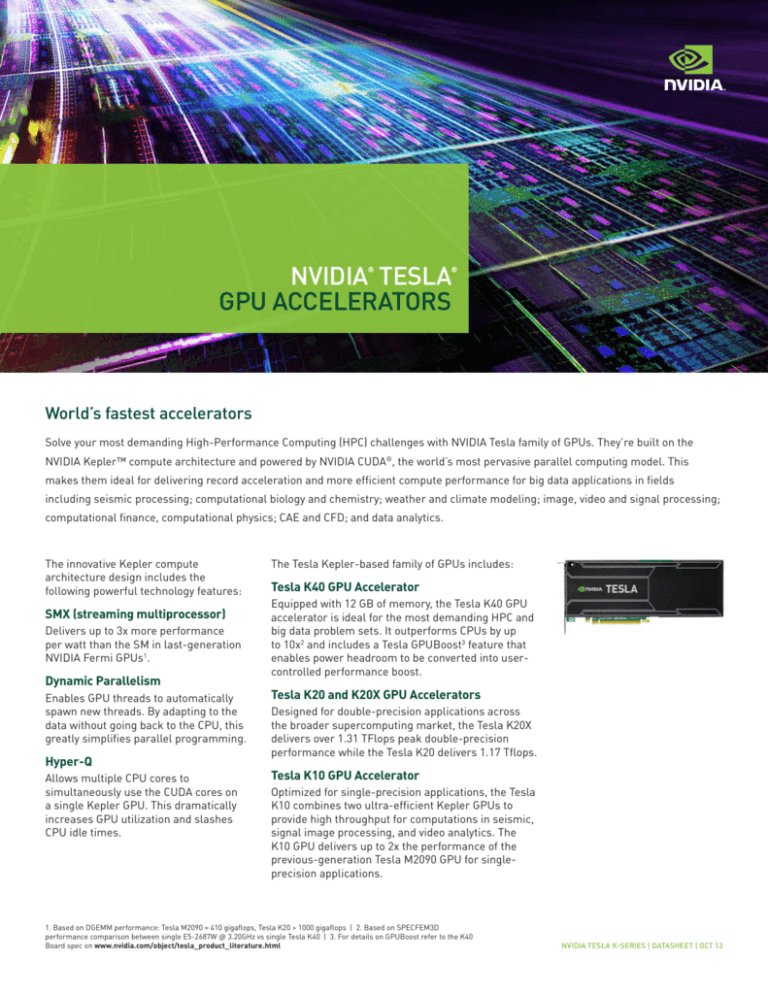
NVIDIA TESLA
GPU ACCELERATORS
®
®
World’s fastest accelerators
Solve your most demanding High-Performance Computing (HPC) challenges with NVIDIA Tesla family of GPUs. They’re built on the
NVIDIA Kepler™ compute architecture and powered by NVIDIA CUDA®, the world’s most pervasive parallel computing model. This
makes them ideal for delivering record acceleration and more efficient compute performance for big data applications in fields
including seismic processing; computational biology and chemistry; weather and climate modeling; image, video and signal processing;
computational finance, computational physics; CAE and CFD; and data analytics.
The innovative Kepler compute
architecture design includes the
following powerful technology features:
SMX (streaming multiprocessor)
Delivers up to 3x more performance
per watt than the SM in last-generation
NVIDIA Fermi GPUs1.
Dynamic Parallelism
Enables GPU threads to automatically
spawn new threads. By adapting to the
data without going back to the CPU, this
greatly simplifies parallel programming.
Hyper-Q
Allows multiple CPU cores to
simultaneously use the CUDA cores on
a single Kepler GPU. This dramatically
increases GPU utilization and slashes
CPU idle times.
The Tesla Kepler-based family of GPUs includes:
Tesla K40 GPU Accelerator
Equipped with 12 GB of memory, the Tesla K40 GPU
accelerator is ideal for the most demanding HPC and
big data problem sets. It outperforms CPUs by up
to 10x2 and includes a Tesla GPUBoost3 feature that
enables power headroom to be converted into usercontrolled performance boost.
Tesla K20 and K20X GPU Accelerators
Designed for double-precision applications across
the broader supercomputing market, the Tesla K20X
delivers over 1.31 TFlops peak double-precision
performance while the Tesla K20 delivers 1.17 Tflops.
Tesla K10 GPU Accelerator
Optimized for single-precision applications, the Tesla
K10 combines two ultra-efficient Kepler GPUs to
provide high throughput for computations in seismic,
signal image processing, and video analytics. The
K10 GPU delivers up to 2x the performance of the
previous-generation Tesla M2090 GPU for singleprecision applications.
1. Based on DGEMM performance: Tesla M2090 = 410 gigaflops, Tesla K20 > 1000 gigaflops | 2. Based on SPECFEM3D
performance comparison between single E5-2687W @ 3.20GHz vs single Tesla K40 | 3. For details on GPUBoost refer to the K40
Board spec on www.nvidia.com/object/tesla_product_literature.html
NVIDIA TESLA K-SERIES | DATASHEET | Oct 13
TECHNICAL SPECIFICATIONS
TESLA K40
TESLA K20X
TESLA K20
TESLA K101
Peak double-precision floating point
performance (board)
1.43 Tflops
1.31 Tflops
1.17 Tflops
0.19 Tflops
Peak single-precision floating point
performance (board)
4.29 Tflops
3.95 Tflops
3.52 Tflops
4.58 Tflops
Number of GPUs
1 x GK110B
1 x GK110
2 x GK104s
Number of CUDA cores
2,880
2,688
2,496
2 x 1,536
Memory size per board (GDDR5)
12 GB
6 GB
5 GB
8 GB
288 Gbytes/sec
250 Gbytes/sec
208 Gbytes/sec
320 Gbytes/sec
Memory bandwidth for board (ECC off)2
Architecture features
System
SMX, Dynamic Parallelism, Hyper-Q
Servers and
workstations
Servers
Servers and
workstations
SMX
Servers
FEATURES AND BENEFITS
Memory error protection
Meets a critical requirement for computing accuracy and reliability in data centers and
supercomputing centers. External DRAM is ECC protected in Tesla K10. Both external
and internal memories are ECC protected in Tesla K40, K20X, and K20.
System monitory features
Integrates the GPU subsystem with the host system’s monitoring and management
capabilities such as IPMI or OEM-proprietary tools. IT staff can now manage the GPU
processors in the computing system using widely used cluster/grid management
solutions.
L1 and L2 caches
Accelerates algorithms such as physics solvers, ray tracing, and sparse matrix
multiplication where data addresses are not known beforehand
Asynchronous transfer with dual DMA
engines
Turbocharges system performance by transferring data over the PCIe bus while the
computing cores are crunching other data
Tesla GPUBoost
End-user can convert power headroom to higher clocks and achieve even greater
acceleration for various HPC workloads on Tesla K40.
Flexible programming environment with
broad support of programming language
and APIs
Choose OpenACC, CUDA toolkits for C, C++, or Fortran to express application
parallelism and take advantage of the innovative Kepler architecture.
SOFTWARE AND DRIVERS
>>Software applications page:
www.nvidia.com/teslaapps
>>Tesla GPU computing accelerators are
supported for both Linux (64-bit) and
Windows (64-bit).
>>Drivers - NVIDIA recommends users get
their drivers for Tesla server products
from their system OEM to ensure the
driver is qualified by the OEM on their
system. The latest drivers can be
downloaded from www.nvidia.com/
drivers
To learn more about NVIDIA Tesla, go to www.nvidia.com/tesla
1. Tesla K10 specifications are shown as aggregate of two GPUs. | 2. With ECC on, 6.25% of the GPU memory is used for ECC bits. So,
for example, 6 GB total memory yields 5.625 GB of user available memory with ECC on.
© 2013 NVIDIA Corporation. All rights reserved. NVIDIA, the NVIDIA logo, Tesla, Kepler, and CUDA are trademarks and/or registered
trademarks of NVIDIA Corporation. All company and product names are trademarks or registered trademarks of the respective owners
with which they are associated. Features, pricing, availability, and specifications are all subject to change without notice. Oct 13
>>Learn more about Tesla data center
management tools at www.nvidia.com/
softwarefortesla


